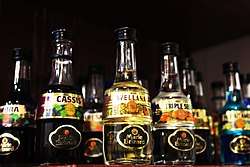Anisette
Anisette, or Anis, is an anise-flavored liqueur that is consumed in most Mediterranean countries, mainly in Spain, Italy, Portugal, Turkey, Greece, Albania, Lebanon, Cyprus, Israel, Palestine and France. It is colorless, and because it contains sugar, is sweeter than dry anise flavoured spirits (e.g. absinthe). The most traditional style of anisette is that produced by means of distilling aniseed,[2] and is differentiated from those produced by simple maceration by the inclusion of the word distilled on the label. And while Pastis is a similar-tasting liqueur that is prepared in similar fashion and sometimes confused with anisette, it employs a combination of both aniseed and licorice root extracts. Sambuca is essentially an anisette of Italian origin that requires a high minimum (350g/l) sugar content.[3]

The liqueur is often mixed with water or poured over ice cubes because of its strong flavour.[4]
Geographical spread
Mediterranean
In the Mediterranean Basin, anise-based or liquorice-based spirits include:
- Spain: Anís del Mono ("the monkey's anisette") has been produced since 1870.[5] The label, with a monkey holding a scroll and a bottle, was designed by Ramon Casas i Carbó.[6] It is the anisette of choice in Malcolm Lowry's Under the Volcano.[7] Characters in Ernest Hemingway's novel The Sun Also Rises[8] and his short story "Hills Like White Elephants" drink and discuss Anís del Toro – "Bull's Anisette." Another type, Aguardiente de Ojén (es), gained fame abroad and is popular in New Orleans, Louisiana, especially during the Mardi Gras festivities.[9][10]
- France: Anisette, made by Marie Brizard since 1755[1] and Pastis, made by Paul Ricard since 1932[4]
- Greece: Ouzo[4]
- Italy: Sambuca[4]
- Portugal: Licor Aniz Escarchado (crystalized)
- Bulgaria and Macedonia: Mastika[4]
- Turkey, Azerbaijan, and Albania: Rakı[4]
- Lebanon, Syria, Palestine, Israel, Jordan, and Egypt: Arak[4]
- Algeria: Anisette Cristal[4]
Latin America
Anise-flavoured alcohols from other parts of the world include Aguardiente from Colombia and Mexico.[11]
Asia
Anise liqueur was also introduced to the Philippines by the Spanish, which developed into the local anisado, an anise-flavored liqueur usually made from distilled sugarcane wine. A notable variant of Filipino anisado with sugar is known as anisado Mallorca, or simply Mallorca. They are commonly used as ingredients in Filipino cuisine.[12][13]
References
- "History of Marie Brizard" (PDF). Cocktail Times. Retrieved 2 January 2018.
- Blue, Anthony (2004). The Complete Book of Spirits. New York: HarperCollins. p. 283. ISBN 0-06-054218-7.
- "REGULATION (EC) No 110/2008 OF THE EUROPEAN PARLIAMENT AND OF THE COUNCIL of 15 January 2008 on the definition, description, presentation, labelling and the protection of geographical indications of spirit drinks and repealing Council Regulation (EEC) No 1576/89". Official Journal of the European Union. European Union. Retrieved 28 October 2016.
- Dealberto, Clara; Desrayaud, Lea (25 July 2017). "Le pastis, elixir provencal". Le Monde. Le Monde. p. 28.(subscription required)
- Zurdo, David; Gutiérrez, Ángel (2004). El libro de los licores de España. Ediciones Robinbook. p. 50. ISBN 9788496054127.
- Eaude, Michael (2007). Catalonia: A Cultural History. Oxford UP. p. 113. ISBN 9780199886883.
- Lowry, Malcolm (2012). Under the Volcano: A Novel. Open Road Media. p. 24. ISBN 9781453286296.
- Hemingway, Ernest (2006). The Sun Also Rises. Simon and Schuster. p. 162. ISBN 9780743297332.
- Dominique Mertens Impex. S.L., Ojén, aguardiente superior Archived 29 November 2014 at the Wayback Machine, official website, in Spanish
- New Orleans Nostalgia, "Banana Republics and Ojen Cocktails", Ned Hémard, 2007
- Franz, Carl; Havens, Lorena (2006). The People's Guide to Mexico. Avalon Travel. p. 96. ISBN 9781566917117. Retrieved 15 February 2013.
- Gibbs, H.D.; Holmes, W.C. (1912). "The Alcohol Industry of the Philippine Islands Part II: Distilled Liquors; their Consumption and Manufacture" (PDF). The Philippine Journal of Science: Section A. 7: 19–46.
- Aranas, Jennifer (2015). Tropical Island Cooking: Traditional Recipes, Contemporary Flavors. Tuttle Publishing. pp. 10–11. ISBN 9781462916894.
